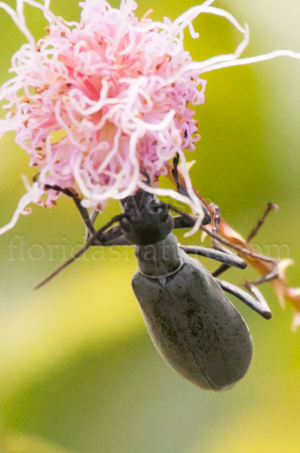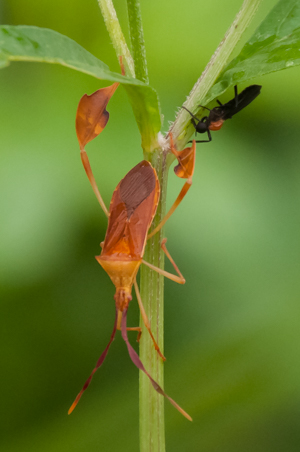Florida Beetles and Bugs
There is an order of insects that are known as the "true bugs" also represented here.
Beetles and bugs may share similar physical characteristics, below is a
check list of the key differences of these two types of insects -
- Beetles - Order Coleoptera
- True Bugs - Order Hemiptera
- Beetles have hardened forewings almost always meeting in a straight line down the back, these forewings are called the elytra, these cover and protect the more delicate membranous hindwings.
- Bug wings (if any present ) are membranous or partially thickened at the base, do not meet evenly on the back
- Beetle mouth parts are mandibles made for chewing and pinching. Diets may consist of plant, animal, or fungal materials.
- Bug mouth parts are modified into a non-retractable needle-like proboscis made for piercing that folds back along the underside of the bug. Diet of most bugs is various plant fluids, however some bugs prey on other insects and a few species are parasitic.
- Beetles undergo a complete four stage metamorphosis - egg, larva, pupa, adult.
- Bugs undergo an incomplete metamorphosis - emerging from the egg as a nymph,as the nymph grows it must molt or shed its hard, thin exo-skeleton. Each time it molts it begins a new developmental stage of life called an instar, the number of instars varies with species. Bug nymphs may or may not resemble the adult and have no wings.
- Beetles typically have 11 antennae segments.
- Bugs have 4-5 or fewer antennae segments.
The order Coleoptera (Beetles) is the largest animal order on earth with almost 390,000 species worldwide and more than 28,000 (an estimated number of 30,00 +/-) species in the U.S., this also represents about 40 percent of all insect species. These numbers are actually increasing as taxonomists identify and catalog new species.
Beetles are found in all types of habitats from bone-dry deserts to species that are purely aquatic throughout their life cycle. They range in sizes from the tiny fairy beetles that are so small as to be barely visible without a magnifier, up to the aptly named Titan beetle that measures in at 6.5 inches long.
Many terrestrial beetles have larvae called grubs, living underground these are white/grayish in color, usually soft bodied with a hardened head "casing" and 3 pairs of legs, they feed on the roots of plants and are considered a major pest to commercial agriculture and the home gardener.
Aquatic beetles also have aquatic larvae that feed on a variety of plant and organic material, some of them are predators of tadpoles, small fish and worms. While having evolved with a variety of sizes, shapes, colors, and diets, beetles still share common physical characteristics.
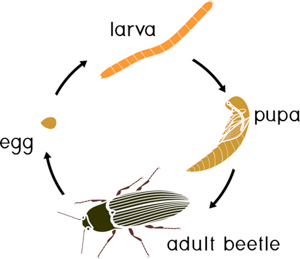
Beetle anatomy
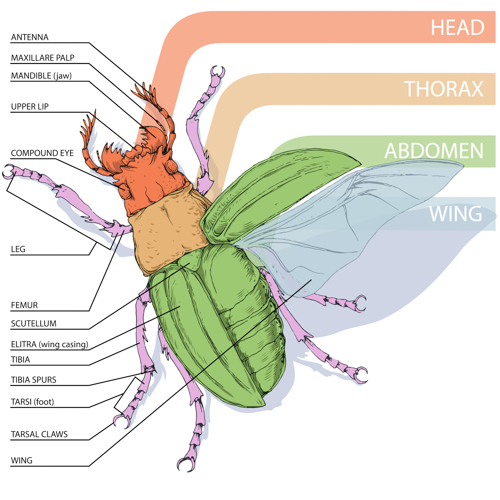
Delta Flower Scarab Beetle - Trigonopeltastes delta
Family - Scarabaeidae
Subfamily - Cetoniinae
(Fruit and Flower Chafers)
sm.jpg)
Named for the distinctive yellow "Δ" marking on the pronatum, adults are 8-11 mm. long and feed mainly on flower pollen from a variety of plants.
Because the larvae feed on rotting wood and other decaying organic material this species is not considered to be an agricultural pest. Adults fly from May through August, are dinural (active during the day) and although it is not well studied they are believed be an important pollinator of native plants and trees.
Six-spotted Flower Longhorn Beetle - Strangalia sexnotata
Family - Cerambycidae
Subfamily - Lepturinae
(Flower Longhorn Beetles)
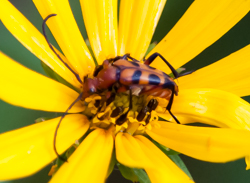
Body length 8 -13 mm, this beetle also feeds on flower pollen and nectar/sap as an adult. Larvae are wood borers, females generally seek out injured or dying trees to deposit their eggs, finding sick trees by following chemical trails that the injured or dying trees emit.
Longhorn beetles are so named because in most of the longhorn beetle species the antennae length exceeds its body length. These beetles are found throughout Florida and most of the southeastern and south-central portions of the United States.
Rainbow Scarab Beetle - Phanaeus igneus
Family - Scarabaeidae
Subfamily - Scarabaeinae
(Dung Beetles)
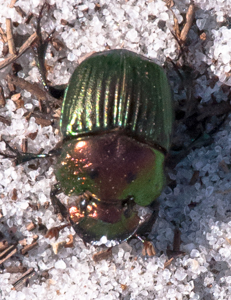
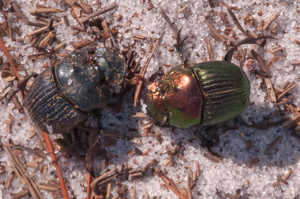
The colorful Rainbow scarab is a dung beetle found in areas of sandy soils, such as scrub habitats. Actual colors vary, may be black, brown, red, or green or a combination.
Ox Beetle - Strategus antaeus
Family - Scarabaeidae
Subfamily - Dynastinae
(Rhinoceros Beetles)
Larvae are generally referred to as "white grubs" and feed on plant roots, adults are burrowers and feed on decaying vegetation and dead wood. Males have prominate horns.
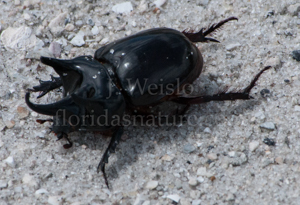
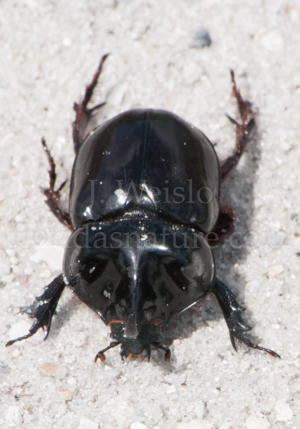
Dark Flower Scarab Beetle - Euphoria sepulcralis
Family - Scarabaeidae
Subfamily - Cetoniinae
(Fruit and Flower Chafers)
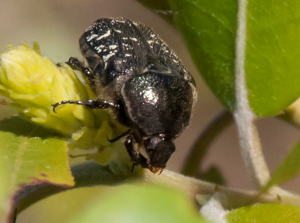
Eggs are deposited under decaying organic matter or manure where the larvae develop and pupate,adults feed on the flowers, fruit and fermenting sap of many different trees, shrubs and herbs. This beetle causes damage to avocado and mango crops in South Florida by feeding on the flowers.
Blue-green Citrus Root Weevil - Pachnaeus litus
Family - Curculionidae
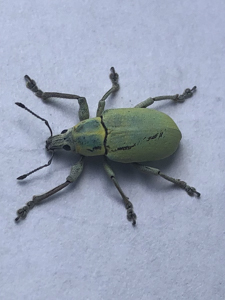
As the name suggests this beetle feeds on citrus trees, the various oranges, lemon, grapefruit are all on the menu. Adults are 8 to 14 mm long and a light blue-green color. Adults prefer the tender new growth of foliage, while the larvae attack from below the soil surface, feeding on the roots of the trees.
The diet is not limited to citrus, this insect feeds on as many as 70 different plants although it is not considered to be a major agricultural pest. This beetle can be found in a variety of habitats - hammocks, pinelands, mangroves, prairies, and salt marshes as well as groves and plant beds.
American Carrion Beetle - Necrophila americana
Family - Silphidae
(Carrion Beetles)
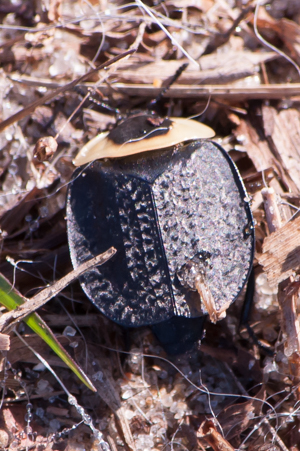
A 1/2" to 3/4" long beetle with a flattened, oval body, the pronatum is yellow with a black central spot, the elytra are black with an an armored appearance, with the abdomen protruding slightly past the wings.
Adults fly during daylight hours and resemble a bumblebee when in flight. Adults and larvae feed on fly maggots, carrion and competing beetle larvae. Active throughout the year in Florida with activity peaking during the spring and summer breeding season, adults overwinter in the more northern parts of its range.
Diaprepes Root Weevil - Diaprepes abbreviatus
Family - Curculionidae
Subfamily - Entiminae
(Broad-nosed Weevils)
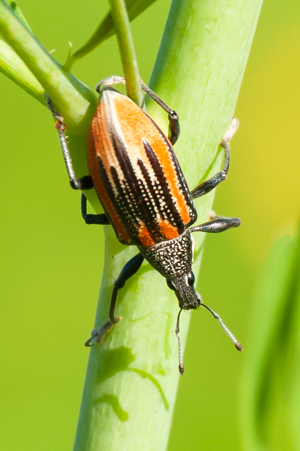
The Diaprepes Root Weevil is an invasive species that was first found in Florida in 1964, it is believed to have come into the state via plant shipments from Puerto Rico.
This insect has become a serious agricultural pest in the southern 2/3 of the state, a single female can produce over 5,000 eggs in a 3-4 month lifespan and a single larvae can girdle a taproot thus killing the plant, larvae feed on the roots of around 270 different host plants including citrus, sugarcane, potatoes and other fruit and vegetable crops.
Three species of wasps that parasitize the eggs of this weevil have been introduced into several South Florida counties in an effort to control these pests.
Cottonwood Leaf Beetle - Chrysomela scripta
Family - Chrysomelidae (Leaf Beetles)
Subfamily - Chrysomelinae
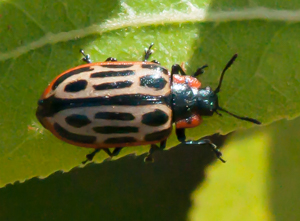
Adults are 1/4" long with a black head and thorax, the outer margins of the thorax are red or yellow, the elytra are yellow-ish with broken black stripes.
Host plants are the willows and poplars, adults cut holes in leaves while the larvae will completely skeletonize a leaf. Primarily a pest of commercial cottonwood and poplar growers, adults overwinter under bark or under fallen leaves and other debris emerging to coincide with the trees new spring growth.
Blister Beetles
Family - Nemognathinae
Florida has 26 species of blister beetles, so named because they produce a chemical called cantharidin that causes blisters on skin and is toxic to mammals if ingested, adult blister beetles are plant and flower feeders and there are cases of horses being poisoned when beetles were inadvertantly crushed in the production of alfalfa hay bales.
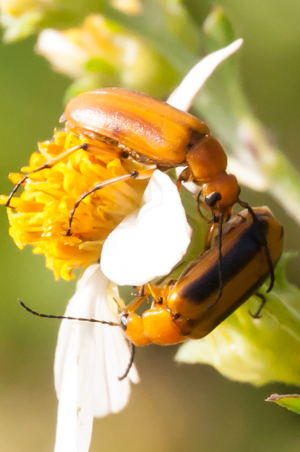
True Bugs - Order Hemiptera (True Bugs, Cicadas, Hoppers, Aphids and Allies)
Cotton Stainer - Dysdercus suturellus
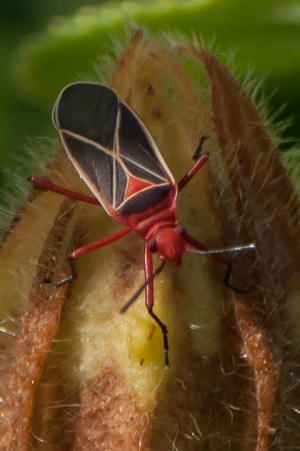
The Cotton stainer gets its name from the yellow stain it causes on cotton bolls when feeding on them, the affected bolls growth is also affected possibly even causing it to drop from the plant. This insect has on occassion been a pest on orange crops, a puncture causing immature fruit to drop from the trees and quickly rot.
Host plants are many and they include Okra, Portia tree, Spanish needles, Ceaserweed and rose buds and flowers.
Life Cycle of True Bugs
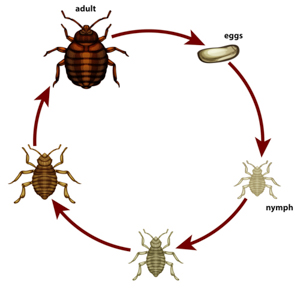
Florida Bee Assassin - Apiomerus floridensis
Family - Reduviidae (Assassin Bugs)
Subfamily - Harpactorinae
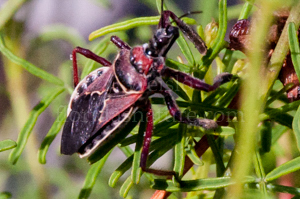
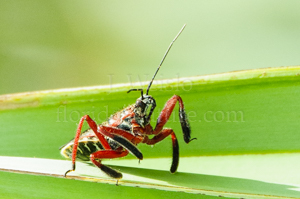
Adults - 12.5 - 16.2 mm, females are larger than males. Bee assassins in general are named for the habit of waiting on flowers to prey on bees that visit, although they feed on other insects as well some species have a sticky resin on their tibia to help them hold prey, the females also use this resin to protct their eggs from predation by other insects. There are 10 species of Bee assassins in the United States, this particular species is named for its distribution through-out Florida's penninsula.
Milkweed Assassin Bug - Zelus longipes
Family - Reduviidae
Subfamily - Harpactorinae
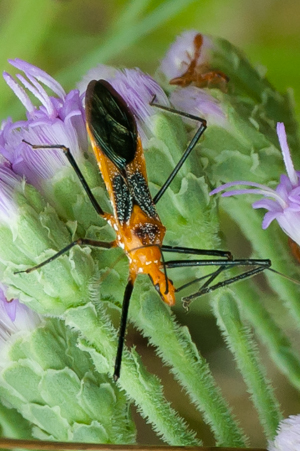
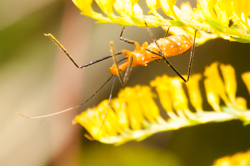
Variable in size and color, Florida average sizes are 16.8 mm (males) and 18.2 mm (females), colors are typically black and orange. Range of this species is through-out Florida and the S.E. United States. Milkweed bugs are ambush predators, hiding in flowers and preying on unsuspecting insects coming to the flowers for nectar or pollen. They grab their prey, quickly using their stylet to inject emzymes into their victim. The emzymes liquefy the preys internal tissues and the bug then sucks the liquids out.
Eastern Leaf-footed Bug - Leptoglossus phyllopus
Family - Coreidae
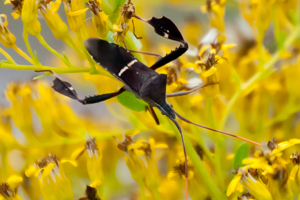
Leaf-footed bugs are plant feeding bugs named for their foliaceous (leaf like) hind tibiae, there are nine species reported in Florida.
Size - 16 mm to 19 mm, a dark chestnut brown color often with an unbroken white line across the elytra where-as other species whith white markings are in a zig-zag pattern, dashes or faint dots. Common on thistle in Fl., also feeds on citrus, tomato and various ornamental plants.
Helmeted Squash Bug -
Family - Coreidae
Subfamily - Coreinae
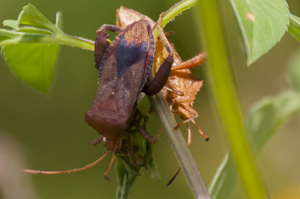
This insect is found throughout Florida and the eastern United States. Somewhat variable coloration, dull brown with darker hind wings, body is 13 - 17 mm long, 5 - 7.5 mm wide, the connexivum or edges of the abdomen may or may not be spotted, humeri are prominate, hind femora are swolllen/enlarged and have spines underneath. Males have a conspicuous white or cream colored spur or projection on the dorsal side of the thorax next to the abdomen.
This bug can be a serious pest on various food crops and ornamental plants, especially roses. Nymphs go through 5 instars, they are variable in coloration - early instars have orange heads and purple-ish to reddish-brown bodies, later instars are orange to yellowish brown and mottled heads, all 5 instars have spikes and a dilated third antennal segment.
Harlequin Bug - Murgantia histrionica
Family - Pentatomidae (Stink Bugs)
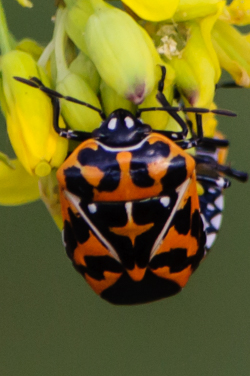
9.5 mm long with a bright orange and black pattern on a shield shaped body. Harlequin bugs are a serious pest on many of Florida's cruciferous vegetable crops with cabbage, brussel sprouts, cauliflower and raddish being among the favored plants, however they will also attack tomato, potato, beans and others.
Cicadas
Family - Cicadidae
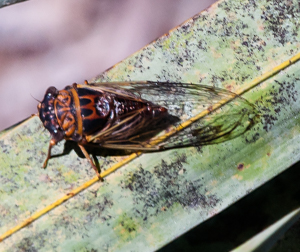
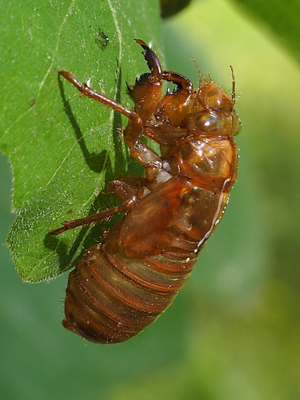
Florida has 19 species of cicadas, none of them are the 17 or 13 year mass emergence species, rather a 4 year minimum life cycle under ideal conditions stretching out to possibly a decade with different generations of adults emerging yearly.
Little is known about the length of these life cycles except they are variable with species and conditions. Nymphs live underground, feeding on sap from the roots of trees or grasses, going through four molts underground then climbing up and clinging to a plant where they undergo a final molt becoming an adult. The discarded castings are more often seen then the actual insects.
Cicadas in Florida are usually heard, the males singing loudly from their perches in trees to attract the females. Each species has a call (or song) unique to that species, enough so to allow for a positive identification, some calls can reach 100-115 decibels.
Large Milkweed Bug - Oncopeltus fasciatus
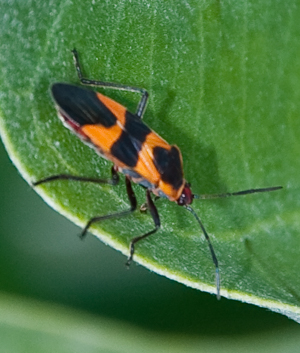
Adults - 10-18 mm long, black and red with a foreward pointing triangle shaped orange patch on the posterior (back) of the forewing and a rearward pointing orange triangle on the anterior (front) portion of the forewings with a black band in the middle of the wings.
This bug feeds on Asclepias (milkweed) seeds and is generally found where these plants grow. As it feeds it also accumulates toxins from the milkweed in its body and will likely sicken any predator foolish enough to ignore the bright warning colors and attempt to make a meal of this bug.
These bugs are not cold hardy and the northern members migrate to the southern Atlantic and Gulf coast states to overwinter, gradually moving northward again with the arrival of warmer spring temperatures.
